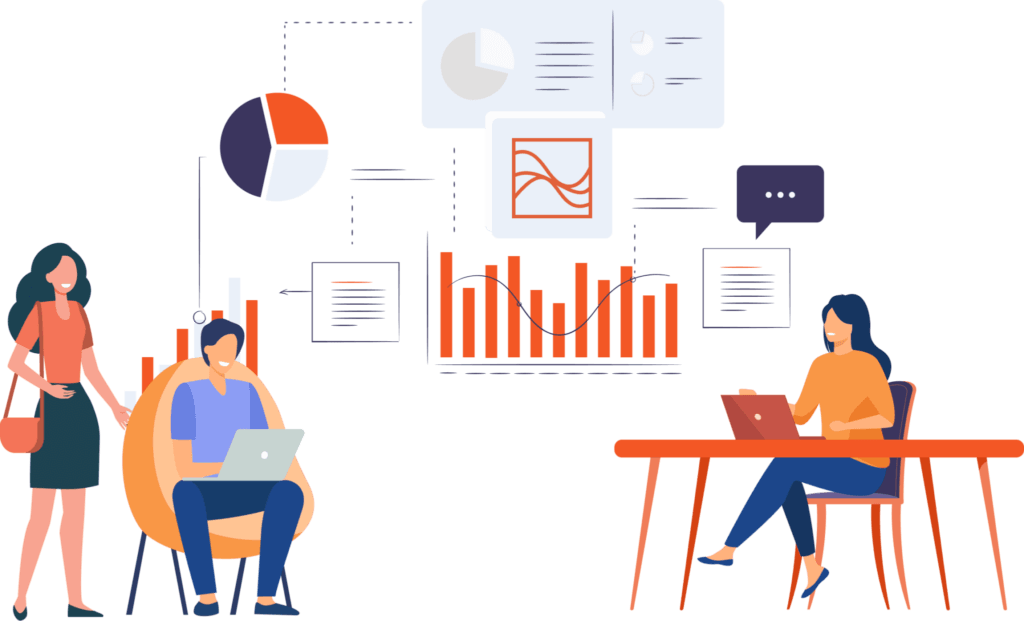
This is your ultimate beginner’s guide to answer all your burning questions on all things CDP. From what CDP stands for to all the amazing benefits you can reap from implementing one, we leave no stone unturned. Bookmark this and share it with your team so that everyone understands all the crucial CDP basics.
Before we dive right in...
Subscribe to our blog today to ensure that you never miss valuable posts such as this one. We are passionate about helping sports organizations deliver a world-class fan experience, because better fan experience means better business. So why not use this opportunity to the fullest?

Here are all the CDP basics to know today
1. What does CDP stand for?
The first thing to know about a CDP is what the acronym stands for. CDP simply stands for Customer Data Platform.
2. What is a Customer Data Platform?
For this, we refer to the CDP Institute. They define a Customer Data Platform as a “packaged software that creates a persistent, unified customer database that is accessible to other systems”.
“packaged software that creates a persistent, unified customer database that is accessible to other systems.”
3. How does a CDP work?
A CDP collects and unifies first-party supporter data, from multiple sources, both online and offline, to build a single, coherent, complete view of each supporter. This is what we call a 360-degree supporter view. After collecting and unifying the data, the CDP then makes that data available to use to power all decision-making. Helping an organization work data-driven. Moreover, this data can be shared with other team members and in fact, other systems. Making data transparency (the ability to use and share data easily) a dream come true for all organizations.
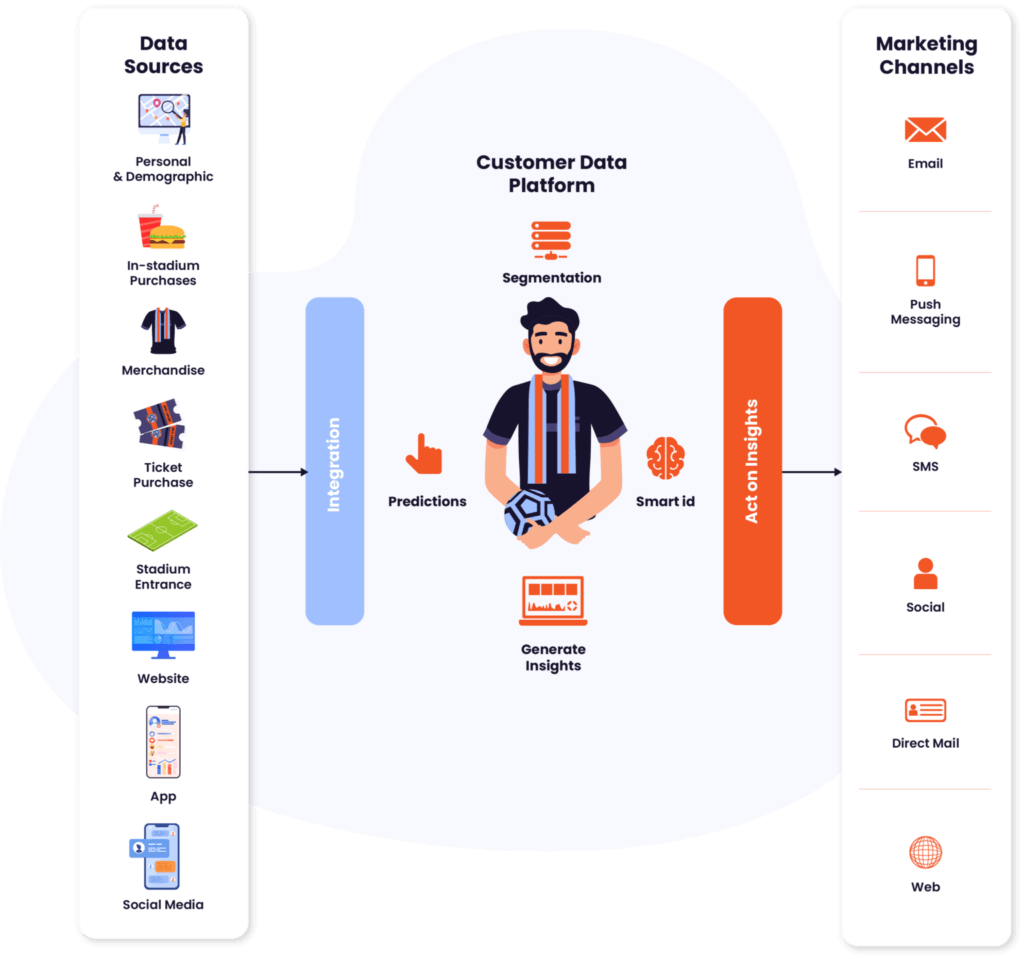
4. What challenges does a CDP solve?
This is one of the most important CDP basics you have to understand. Understanding this will help you reap the most benefits out of your CDP implementation strategy. Historically, marketers and all those who had a keen interest in working data-driven had a few but major issues.
- Firstly, most organizations had a problem with siloed data. This means data that is kept in separate sources. Making it scattered and very difficult to work with.
- Secondly, having data stored across different sources meant that sports organizations did not have a unified view of who their supporters were. Making it almost impossible to understand them.
- Thirdly, because this data was siloed, it meant that it was hard to share it with relevant team members, within a department and more especially, outside of that department. As such the process of data sharing data demanded a lot of time and effort.
With this siloed incomplete data that was difficult to share, one can only imagine how difficult it was to make informed decisions. Having peace of mind and confidence in one’s data was something completely unheard of. As such marketers struggled with:
- creating specific and effective marketing campaigns,
- establishing a supporter base,
- not only that but expanding that base,
- or on the flip-side, reducing churn, that is, sports organizations had no concrete way of ensuring that supporters stayed loyal to their organization.
- identifying and leveraging new revenue opportunities
- creating strategies that work such as sponsorship strategies to boost the value of sponsorship deals
- selling out products such as merchandise and tickets for sports organizations, for example.
This is one of the most important CDP basics to bear in mind because the problems the CDP solves, are also the use cases of the CDP.
5. When was the CDP launched?
Around the year 2013 is when the term CDP started surfacing. This was due to all the problems discussed above. Moreover, increased demand for improved fan experiences and omnichannel approaches made a CDP paramount for any kind of organization. This is something crucial to bear in mind because the need for a CDP extends beyond just the organizations’ needs for an effective solution to their problems to encompass the needs of supporters.
6. What are the benefits of using a CDP?
We will fit in as many benefits here as possible because we understand that this is one of the top three most important CDP basics everyone wants to know about. But please bear in mind that this is by no means exhaustive. But here are a few benefits of a CDP:
- a CDP helps eliminate silos
- it unifies data giving you a 360-degree supporter view
- updates data with every interaction your supporters make with your sports organization – making the data accurate and reliable, all the time
- you can easily share the data in a CDP with others in your entire organization (not just your department) and other systems making data transparency easy
- a CDP is privacy law regulation compliant, think GDPR and the like here. So you can rest assured in this area
- CDPs can help you identify key behavioral patterns of your supporters helping you understand them better
- a CDP will help you with your segmentation process – it is unparalleled in this area
- after you have segmented, you can then create personalized campaigns for better results, for example, higher engagement rates
- CPDs can help you increase your merchandise and ticket sales
- they can also help you boost your sponsorship value
- CDPs help you power your data-driven strategy
- they give you peace of mind and confidence that each decision you make is based on facts and data
- CDPs can help you find new business and revenue opportunities
- they optimize processes throughout the organization, processes such as data transparency, decision-making time, collaboration
- they help you identify upsell and cross-sell opportunities, helping boost your revenue
Have a look at the results the Data Talks CDP achieved for a customer (all in 2 weeks) below:
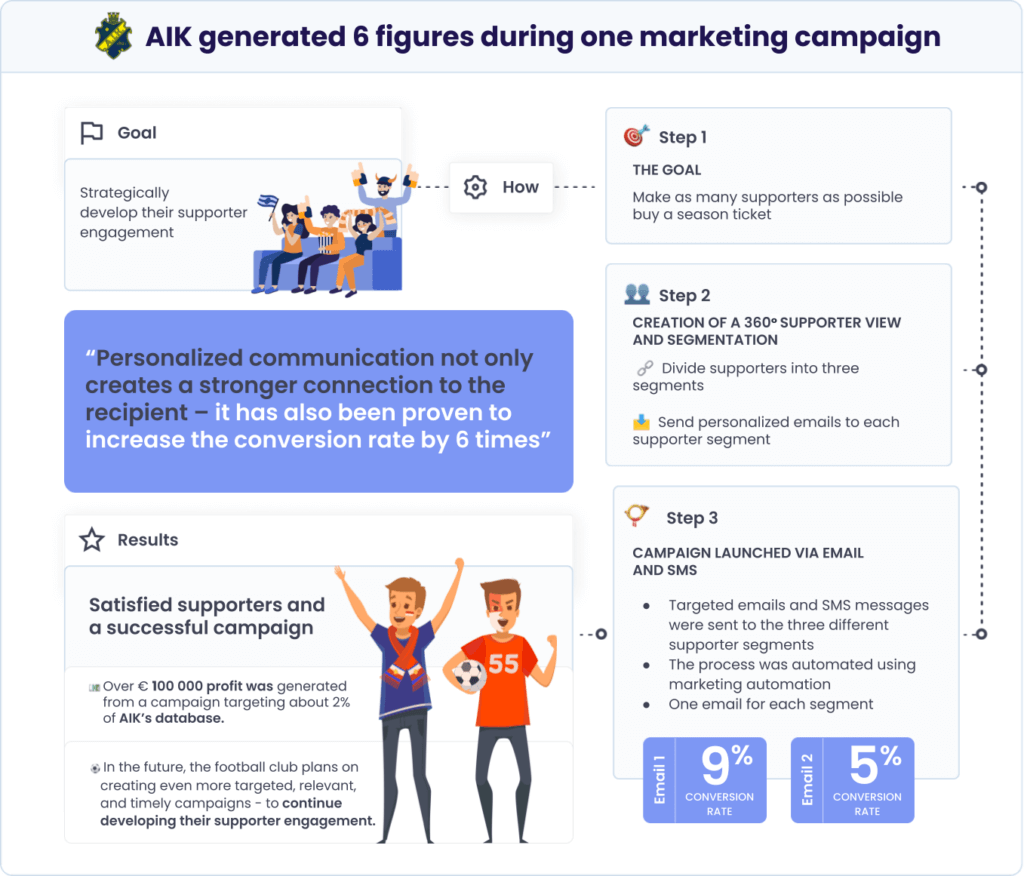
7. What are CDP use cases?
A CDP, a Customer Data Platform, has many uses. So, when we say CDP use cases, we mean all the different ways you can use a CDP to meet your organizational goals. Think of the problems that a CDP solves and the benefits of a CDP, both of which we discussed above, as CDP use cases that you can get started with today. This is one of the most practical and powerful CDP basics to keep in mind.
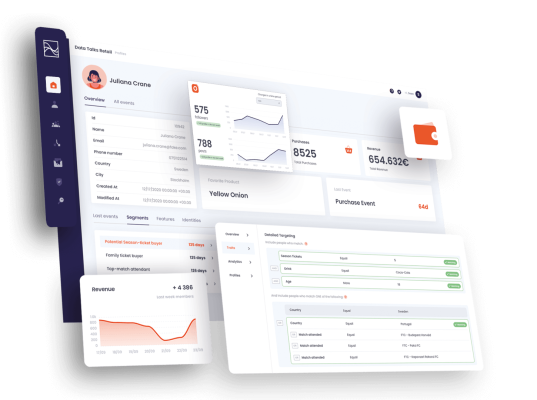
To see how this would look in action, explore the Data Talks CDP demo >>
8. What kind of data can you store on a CDP?
Historically, organizations depended on third-party cookies to get supporter data. But due to privacy regulations such as GDPR, these kinds of cookies have quickly reached their expiry date. Read more on the death of third-party data in one of our blog posts. Thankfully, the CDP never relied on this kind of data.
The CDP primarily stores first-party data, the kind of data your supporters freely allow you to collect whenever they interact with you. The CDP also collects second-party data to enrich the first-party data.
9. Does this make the CDP privacy regulation compliant?
This is one of the CDP basics that makes the CDP such a powerful and attractive piece of technology for marketers. CDPs are indeed privacy regulation compliant. So you can say goodbye to worrying about GDPR because as mentioned above, the CDP primarily collects first-party data, which is by default, GDPR compliant.
10. Where does the CDP collect this data from?
Knowing this will help you understand the wonder that is a CDP. So, you must know where the CDP collects data from, as one of the most fundamental CDP basics to keep in mind. This is not by any means an exhaustive list. And bear in mind that, if there is an integration for a specific data source available, a CDP can collect data from it. Additionally, if you have files, you can upload this data onto the CDP as well. But here are a few CDP data sources:
- online shop
- offline shop
- ticketing system
- event sign-ups such as activations, matches, etc
- website
- sign-up sheets such as newsletter sign-ups
- mobile applications
- other systems such as the CRM, Marketing automation tools
11. How is the data collected?
For most, this is not a crucial question. But for others such as IT and digital gurus, this is one of the most fundamental CDP basics for them to understand. In a nutshell, the CDP collects data through application programming interfaces (APIs), event trackers (e.g. JavaScript tags and SDKs), server-to-server integrations, and manual imports.
12. How does a CDP differ from a CRM?
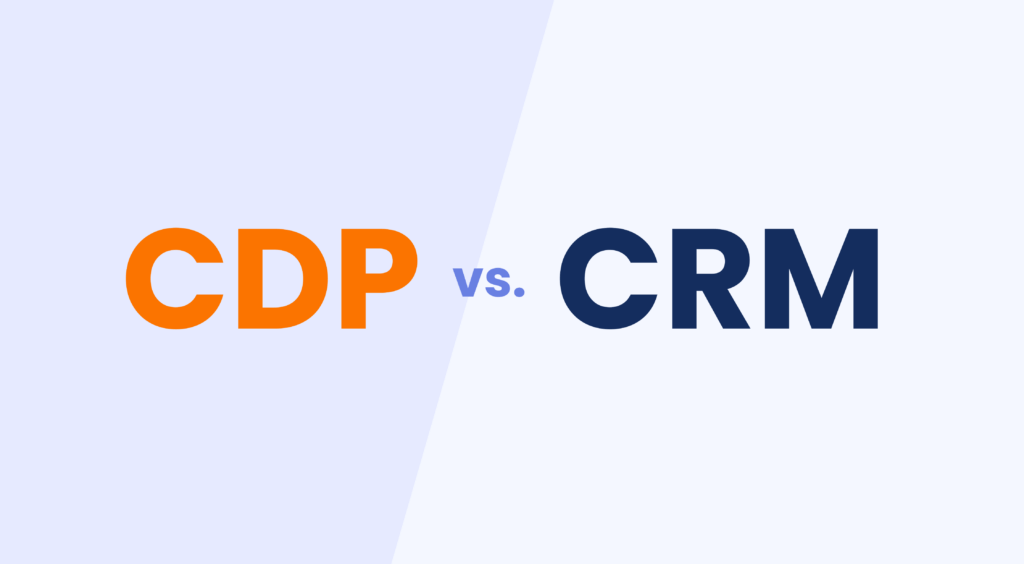
We wrote in depth about this because this is yet another one of the most important CDP basics to know. Read that blog post for more details. In a nutshell, however, a CDP differs from a CRM in that:
- the primary function of a CDP is data collection and unification to give an organization a 360-degree view of its supporters while the CRM’s primary function is to manage the relationship between the organization and its supporter base
- secondly, the primary purpose of the CDP is to understand supporter behavior while the CRM aims to organize and manage supporter-facing interactions with your team
- marketers are the typical end users of the CDP while the CRM is intended for the sales team
- CDPs can collect data both automatically and manually while a CRM only collects data manually
- Once again, the CDP is privacy regulation compliant by default while that is not necessarily always the case with the CRM
- A CDP gives a full 360-degree view of your supporters while a CRM does not.
Be mindful that some CRM providers claim to give a 360-degree view of supporters. Since this is not an inherent function of the CRM, always ask for more details when you see this claim.
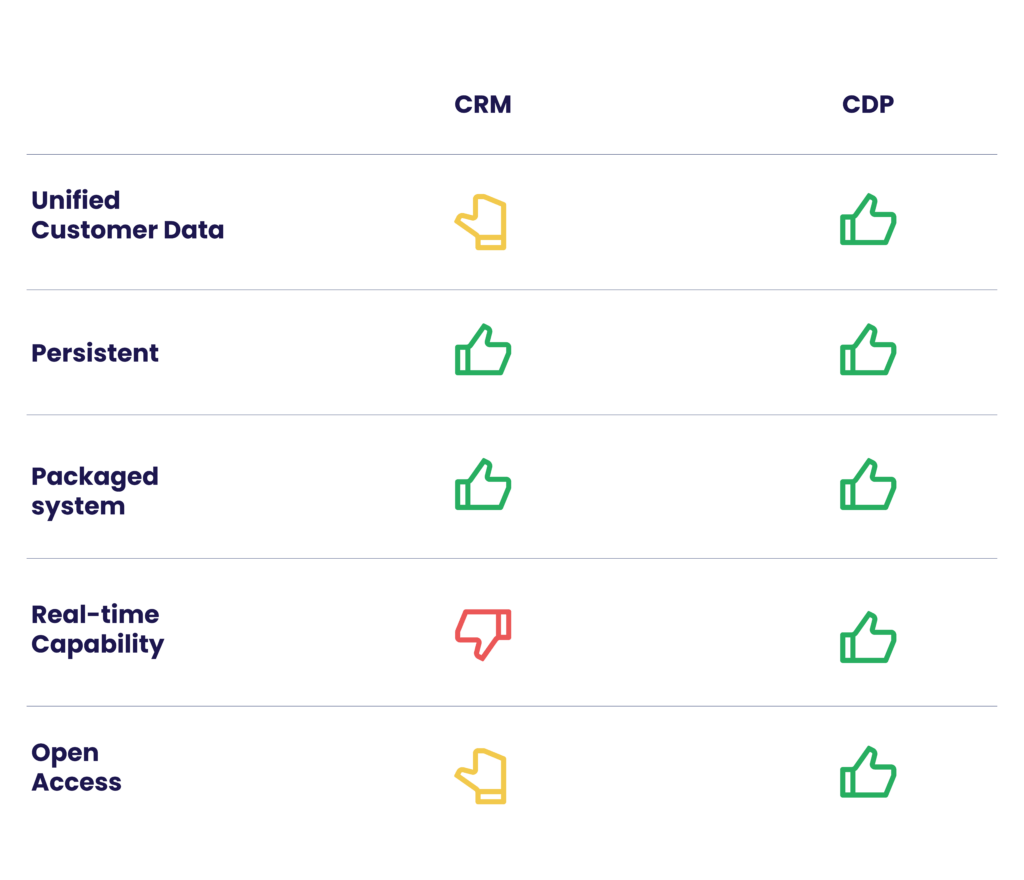
13. How does a CDP differ from other data storage solutions?
Here’s a succinct summary from the CDP Institute: [the features of CDPs …]
- distinguish CDPs from other systems that work primarily with their own data (such as Customer Relationship Management),
- store only limited details for limited periods and include large volumes of externally-owned data (Data Management Platform),
- do not maintain a permanent database (Integration Platform)
- and interact directly with customers (Email, Mobile App, and Web Content Management).
- Other systems may provide similar functions to a CDP. These include data warehouses and software suites or marketing clouds. Often these are limited to structured data or internal inputs.
14. Are there any misconceptions about CDPs?
Just like with everything else, misconceptions about CDPs exist. And if you are not careful, you might lose out on one of the best, if not the best, marketing tools ever invented. So, indeed, this is one of the most important CDP basics to know today. Several CDP misconceptions include:
- A Customer Data Platform is the same as a CRM – we have already covered this one so don’t fall for this misconception.
- Customer Data Platforms are the same as Data Warehouses/Lakes
- A CDP is the same as a DMP
- CDPs are a marketer-managed and marketer-only system
- A CDP’s main capability is Identity Resolution
- CDPs are known for handling only personally identifiable first-party data
- Implementing a CDP involves the replacement of our Marketing Automation or visualization software
- The implementation of a CDP takes years
- CDPs are all the same
This list is by no means exhaustive but if you hear any of these statements, know that it is not true.
15. Speaking of implementation, how long does the CDP implementation take?
Let’s address one of the above CDP misconceptions: “the implementation of a CDP takes years”. This is one of the most important CDP basics to understand. Knowing this will help you approach potential vendors with great confidence. Read more about how to differentiate the best CDP vendor from an ok one. Because why settle for an ok when you can have the best, right?
There are different stages of the implementation process. But most often when people talk about this, they are referring to the onboarding process. That is the process of having your data up and running on the CDP so you can start using it to power all your organization’s decision-making.
How long it takes to implement a CDP differs from vendor to vendor. However, let’s use the Data Talks CDP implementation period as a point of reference:
With Data Talks’ CDP, you’ll be up and running in less than a couple of weeks. Immediately, you’ll be able to analyze your supporters’ behavior on your website or e-shop. Moreover, within four weeks, you’ll be able to unify that with data from your ticketing system and any other systems you use.
With Data Talks’ CDP, you’ll be up and running in less than a couple of weeks. Immediately, you’ll be able to analyze your supporters’ behavior on your website or e-shop. Moreover, within four weeks, you’ll be able to unify that with data from your ticketing system and any other systems you use.
16. Which CDP vendor should you choose?
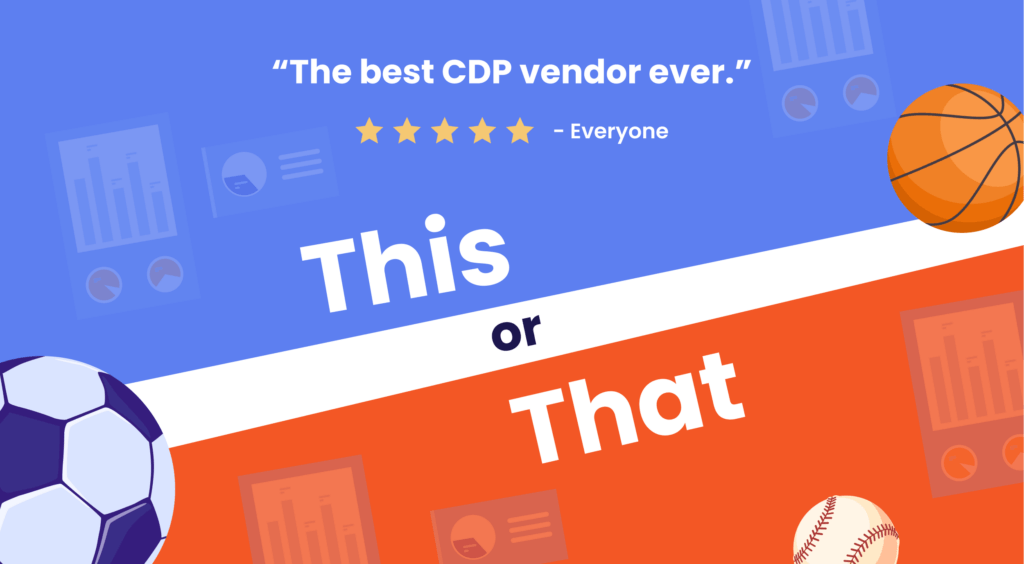
This is one of the most paramount CDP basics many organizations grapple with. But here are a few considerations to get you started:
- are they certified by the CDP Institute as a REALCDP™
- do they have insider knowledge and know-how on your industry
- what is the actual functionality of the CDP relative to its price
- what results has the vendor achieved for their existing customers
- does the vendor guarantee you a certain level of support
- is the vendor’s CDP interface simple and easy to understand
- how often does the vendor update the CDP and/or release new features
These are but a few considerations. Read more on 5 fundamental questions to ask before buying a CDP.
Although this might initially feel like a lot of considerations, we are giving you all these considerations to give you peace of mind. We have great experience working with CDPs and know which questions matter the most to different stakeholders.
Here’s another crucial consideration: what does your gut say about your potential vendor of choice?
Here’s what Kevin Johansson, business to consumer manager at Västerås IK, one of our customers, had to say about why they chose to work with Data Talks:

“After our first meeting with Data Talks, I already knew that this was the partner we needed to work with. The quality of the service, such as the scope of the service and the design, in combination with their expertise in sports, made choosing Data Talks a given. It is, of course, hard to choose just one thing, but in general, it was the overall feeling of the service.”
– Kevin Johansson | Business to Consumer Manager at Västerås IK
Are you getting the same feeling from your vendor?
17. How can you get started today?
Actions speak louder than words. And action is the bridge between your dreams and them becoming a reality. So this naturally raises the question, how can you get started today? You could go and research each item we discussed in this post and then take some time considering which option to start with. But why waste time? Why not start right where you are? You don’t have to leave this page or search for any other thing on the internet.
By simply pressing the link below, you can get started by exploring our CDP demo so you can see everything in action. So, what are you waiting for?
